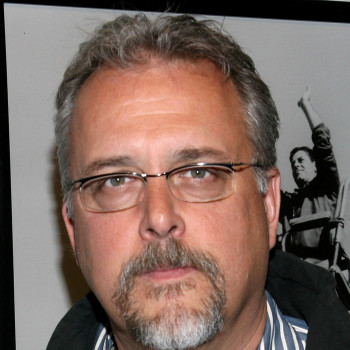Skip Lievasy is nominated for two Oscars this year: one for his work on “Gravity,” and one for “Inside Llewyn Davis” – competing against himself in the sound mixing category. Mr. Lievasy is pretty much a regular on the red carpet, having been nominated for Oscars in previous years for “True Grit” and “No Country for Old Men,” and having assembled a stellar and eclectic CV working on films from “Do the Right Thing” to “An Inconvenient Truth” to “The Hunger Games: Catching Fire.” He teaches Rico about the difference between Oscar’s two sound categories, the importance of letting talk sound like talk, and how he turned a door into a car.

Rico Gagliano: So first of all, as anyone who has ever tried to win their Oscar-watching bidding pool knows, there are two sound categories at the Oscars. There’s sound editing and sound mixing. What is the difference?
Skip Lievasy: It’s basically like, if you were going to make a cake, you would have a crew that would assemble all the ingredients, and there would be another crew that would mix it all together and pour it into a bowl. So the editors would be the ones getting the ingredients assembled. The correct ones. Then the mixer would be the one putting it all together in a bowl and pouring it into the baking pan.
Rico Gagliano: So basically, the sound editors gather sound and create and gather sound effects and different sounds, and then your job is to put it all together so they sound good?
Skip Lievasy: That’s it.
Rico Gagliano: All right. At last! But here’s my question: it’s not always true that you have two people doing that job. Like, when I make a cake at home, I do both of those jobs. Why are they so separate?
Skip Lievasy: Actually I do both quite often. I did both jobs on “Llewyn Davis.” And in the past I have received two nominations for the same year for the same film. But I think it is far more common that there are actually two different crews operating quite separate and independently.
Rico Gagliano: So you do both. Which one would you prefer if you had to choose one or the other?
Skip Lievasy: That’s a tough question.
I really enjoy the editorial part, because you’re very deeply involved up to your neck and ears in all the little things that are going to make the movie into something special, and you’re spending a lot of quality time with the artists — the director and the filmmakers.
The mix is also very exciting for another reason though, because everything is coming together and it’s a very expensive, heavy process. It’s kind of the big finale.
Rico Gagliano: So it’s kind of: One is being more out in the world and working with artists, while one is being surrounded by beautiful technology and weaving stuff together.
Skip Lievasy: And sweating every single syllable!
Rico Gagliano: Let’s hear a couple of examples of your work, and then you can tell us about the intricacies involved. First of all, we’ve got a clip from “Gravity.” Which for the five people who haven’t seen it, is about space-walking astronauts. Their ship is destroyed. They try to survive while floating in orbit over Earth. This is the moment early on where all hell breaks lose.
Rico Gagliano: So I can tell you — I do a lot of sound mixing for this show, and listening to that clip gives me nightmares. It is so complicated. First of all, do you remember how many sound elements were involved in there? How many individual sounds?
Skip Lievasy: Probably more than two hundred.
Rico Gagliano: Where do you begin with something like that?
Skip Lievasy: It’s all about the dialogue. Drama is all about what the actors are doing and how they are relating to each other, and how they’re informing the audience about what’s happening and what they’re feeling, and that almost always comes across in the expression on their face and what they’re saying.
Rico Gagliano: In this case, both of those stars are in spacesuits, so their voices are constantly manipulated — they’re always speaking through intercoms, or they are inside a helmet. What were the difficulties of that?
Skip Lievasy: It became a matter of having as little of the radio-processing on the voices as we could get away with, because the more filtered the voices were, the less dramatic the detail and depth of the performances. We were diminishing the performances, the more filtering, the more realistic we tried to make it.
Rico Gagliano: I can just imagine the arguments over incremental details that must start happening. “No, we need just a little more crackle.” “No, that’s a little too much crackle; we’re losing a little bit of emotion.”
Skip Lievasy: That was it! We had that discussion continuously for three weeks.
Rico Gagliano: Let’s move on, to probably my favorite movie this year: “Inside Llewyn Davis.” Totally opposite end of the spectrum here.
Skip Lievasy: Favoritism, huh?
Rico Gagliano: Sorry dude — that’s what I’m rooting for. It’s about a struggling folk musician in the sixties. This is the scene where Llewyn is in a car, on a road trip, talking to a jazzman played by John Goodman, who is not a fan of folk music.
It seems so simple, that scene. What’s so special about it?
Skip Lievasy: That scene was filmed in a stationary car, and the whole travelling image was created digitally.
Rico Gagliano: So you created all of that road sound. None of that really exists.
Skip Lievasy: “Created” is a bit of a broad term for recording a bunch of automobile sounds, but yes!
Rico Gagliano: But you’re being humble though. There’s more to this scene than that — the sound of the cars driving by, you can tell there’s a lot done to recreate that “whoosh.”
Skip Lievasy: We did. It was a bit of a challenge, those car-bys.
Rico Gagliano: What is that?
Skip Lievasy: A car-by. So when a car passes by, it’s like the automobile equivalent of a foot step. A “car-by.” We kind of went to the basics: had a recorder, and drove a car by the recorder. But often times, particularly at the volume that we ended up playing it to be realistic, it sounds kind of like ‘whooom.’
Rico Gagliano: It doesn’t have impact.
Skip Lievasy: No. So we added a sound. If you analyze it, when a car passes you by on a two lane black top, going the opposite direction, that creates kind of a “whoosh,” like a wind, which doesn’t actually sound like a car. Just sounds like a [imitates wind sound] “whooooo.”
So actually the whoosh that we used is a sound that I recorded for “Barton Fink” for the Coen Brothers years ago.
Rico Gagliano: It’s from the movie “Barton Fink?”
Skip Lievasy: Yeah — it’s from a recording studio door that had a big difference in air conditioning from one side to another, so whenever you opened that door, you got a big [imitates wind sound again] “whooooo.”
Now that sounds like a car-by, doesn’t it?
Rico Gagliano: Yeah! Why didn’t you just use your voice and put it on the soundtrack? That was a pretty good imitation right there.
Skip Lievasy: It’s tempting.
Rico Gagliano: I’m sure it is! Skip Lievasy, good luck on Oscar night.
Skip Lievasy: Thanks so much.


